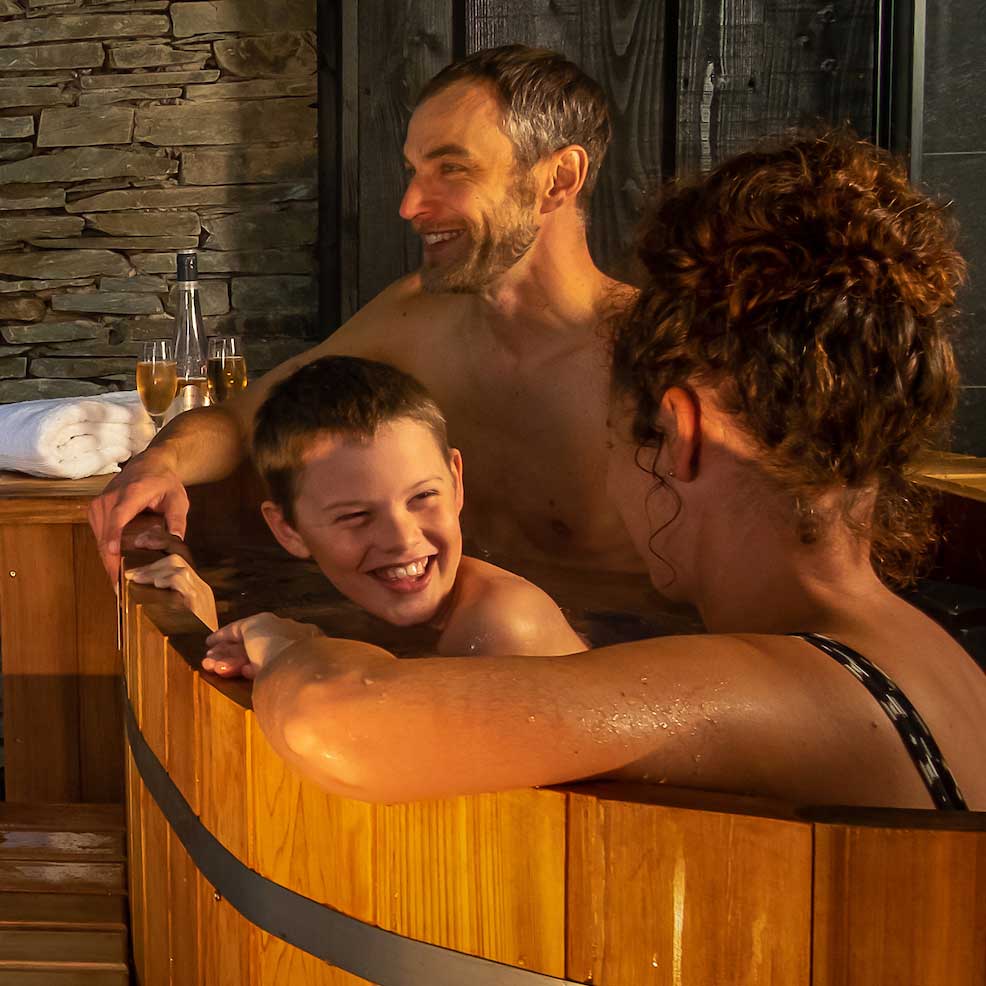Cedar Wood Hot Tub FAQs
- Relaxation: Hot tubs can provide a relaxing and therapeutic experience for your mind and body.
- Health benefits: Regular use of hot tubs may help reduce stress, ease muscle and joint pain, and improve circulation.
- Socialising: Hot tubs are a great way to entertain guests and spend time with friends and family.
- Aesthetics: Cedar wood hot tubs are beautiful and natural-looking, adding to the overall ambiance of your outdoor living space.
They’re not Thermowood – our wooden tubs are made with 40mm thick A Grade Clear Western Red Cedar without any cheap fibreglass/acrylic shells.
It’s not just a hot tub – its the whole package, for example look what’s included with our Classic Deluxe’s:
- Balboa Electric Spa pack and Heater
- Balboa digital spa pack with 3kW electric heater
- Balboa 4kW auxiliary heater
- LCD top side digital controller
- 8 Hydromassage jet system
- Powerful 2 stage pump
- 3 Colour LED mood lighting
- Water Treatment & Filtration System
- 2 x 50 sq ft filter
- Clear Blue Mineral Ionizer
- Ozone water purification system
- Complete starter chemical kit
- Deluxe Cedarwood Pack
- Custom control shelf with hinged wood cover for the LCD controller and two air control ports
- Cedar skirting to hide the plumbing
- Custom cedar enclosure to match tub radius with removable top and hinged front door. Used for protecting the mechanics from the elements
- Custom cedar stairs with a railing that matches the radius of the hot tub
No, it is not recommended to stain the inside of a cedar wood hot tub. Cedar wood is naturally resistant to decay and rot due to its natural oils and resins. Staining the inside of the tub can potentially damage the wood and negatively affect the water chemistry. Additionally, the chemicals used in the stain can be harmful to people using the tub. It is best to leave the inside of the cedar wood hot tub untreated to ensure its longevity and safety for users.
This will depend on the volume of the water, the starting temperature and the heating system being used. Generally, with an electrical system and auxiliary heater the Ofuro can take 2 hours and the Classic 4 hours to heat the water to the desired temperature. These make them ideal options for the hospitality sector that need a quick turnaround.
Yes.
Because Cedar’s rich oils give it a natural resilience to decay, cleaning them is just as easy as it is for plastic tubs. Use a soft-bristled brush or a sponge and a mild cleaner to clean the surface of the hot tub. Avoid using harsh chemicals or abrasive cleaners that can damage the wood.
To ensure the safety of your hot tub, it must be placed on a solid and level surface that is capable of supporting the weight of the hot tub, water, and its users. Placing a hot tub on grass or bare ground is not recommended, and we suggest seeking the help of a qualified contractor to create a suitable foundation.
There are several options available for a hot tub foundation, including concrete, paving stones, and decking.
Concrete
For a concrete foundation, we recommend excavating a 150mm/6inch deep area, laying 50mm/2inches of MOT type 1 sub-base gravel, and filling the area with a minimum of 100mm/4inches of concrete.
Paving Stones/Slabs
Paving stones are a cost-effective solution that offers a variety of sizes, shapes, and finishes. For a paving stone foundation, we advise excavating an approximately 130mm/5inch area, laying 50mm/2inches of MOT type 1 sub-base gravel, and then laying 25mm/1inch of dry mix/cement sand on top of the MOT gravel. Bed the chosen patio slabs/stones into the compacted cement sand.
Decking
Decking can also be used as a base for a hot tub, but it is important to consult with a qualified professional to ensure that the decking can support the weight of the hot tub. For a minimum decking base, support joists should be a maximum distance of 200mm/8inches apart.
Crushed Stone / Gravel
A crushed stone or gravel base can also be used, especially for smaller hot tubs. The area should be levelled and compacted, and a weed barrier installed before adding the stone or gravel.
Indoors
If you are installing the hot tub indoors, a concrete or tile floor may be suitable, but you may need to reinforce the floor if it is not already designed to support heavy loads.
It is recommended to consult with a licensed contractor or engineer to determine the appropriate foundation for your specific hot tub and location.
No, you cannot use just any chemical for sanitisation in a cedar wood hot tub. It is important to use chemicals that are specifically designed for use in hot tubs and are safe for the wood material. Using harsh chemicals or improper dosages can damage the wood and potentially harm those using the hot tub. It is recommended to use natural, non-chlorine-based sanitisers that are safe for use in cedar wood hot tubs, such as bromine or mineral-based sanitisers. Additionally, regular water testing and maintenance of proper pH and alkalinity levels are essential for the longevity of the hot tub and the health of its users.
Yes, Cedar Wood Hot Tubs can be installed indoors, but proper ventilation and drainage systems must be in place to avoid moisture buildup and mold growth.
The frequency of water changes depends on the usage of the hot tub, the size of the tub, and the chemical treatment of the water. Generally, it’s recommended to change the water every three to four months.
Yes, Cedar Wood Hot Tubs can be used year-round with proper insulation and heating systems. However, extreme weather conditions may affect the performance of the hot tub. The water will need a heat source to avoid freezing so the wood-fired hot tub will need emptying when not in use.
It is important to ensure that your hot tub is connected to the correct electricity supply to prevent any accidents or electrical faults.
The standard heater is 32AMP – a 6mm² 3-core SWA cable is required.
If being supplied with the auxiliary heater then a 10mm² 3-core SWA cable is recommended.
In addition, an IP65 45AMP Rotary Isolator Switch is also necessary to isolate the hot tub during an emergency or service work.
It is important to ensure that the isolator switch is sited at least 2 metres away from the hot tub to prevent bathers from touching it. The electrician should fit a suitable weatherproof block connector to the end of the tail from the isolator, and waterproof gland packs should be used to prevent water ingress on all electrical connections. Earth cables should also be clearly colour coded with green/yellow insulating tape or earth sleeve.
The electrical installation must comply with BS:7671 – “Requirements for electrical Installations IET Wiring Regulations,” particularly concerning the hot tub’s maximum amperage pull. The hot tub must be hard wired on its own fused spur back to the household consumer unit, not sharing a supply with any other appliances. It should also be protected by a sufficiently rated MCB and an RCD.
Outdoor cabling should be protected from damage by either laying protective ducting (pc pipe) below ground or by using Steel Wired Armoured (SWA) cable. It is recommended to seek professional advice from a fully qualified electrician if in doubt about the required electrical guidelines.
It is advised that your electrician leaves enough spare cable attached to the isolator to reach the furthest side of the hot tub, usually a minimum of around 7m to 8m. If the isolator is located further away, a longer length of cable should be used.
No, you can use a hose pipe to fill your hot tub with water.

